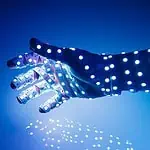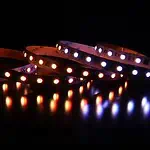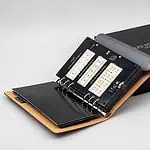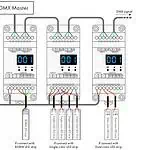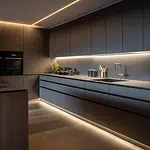As an experienced interior designer specializing in lighting, I have spent years transforming spaces by carefully selecting and implementing the right lighting solutions. My journey in the design world has taught me that lighting is not just about visibility, but it’s about creating an experience, setting the mood, and enhancing the functionality of every room.
With certifications in lighting design and a portfolio that includes both residential and commercial projects. In this blog post, you can expect to gain comprehensive knowledge that will help you choose and implement ambient lighting that perfectly complements your space.
Ambient lighting, often referred to as general lighting, is the foundation of any good lighting plan. It provides the primary source of light in a room, ensuring that it is evenly illuminated without harsh shadows. The right ambient lighting can transform a room, making it feel warm, inviting, and functional. Unlike task or accent lighting, which have more specific roles, ambient lighting is essential for setting the overall mood of a space.
This blog will give you a complete guide about ambient lighting, including its benefits, where and how to use it, and various aspects of ambient lighting, from understanding its purpose to choosing the right fixtures and integrating it seamlessly with other layers of lighting.
What Is Ambient Lighting?
Ambient lighting is the base layer of lighting that provides overall illumination in a room. It’s designed to create a comfortable level of brightness without glare, allowing people to see and move around safely. Unlike task lighting, which is focused on a specific area, or accent lighting, which highlights particular features, ambient lighting covers the entire space. It sets the tone for the room, whether it’s a soft, relaxing glow for a bedroom or a bright, welcoming light for a living room.

The Purpose of Ambient Lighting
The primary purpose of ambient lighting is to ensure that a room is well-lit and comfortable to be in, no matter the time of day. It complements natural light during the day and serves as the main source of illumination in the evening.
Ambient lighting is crucial for creating a balanced lighting scheme, where all areas of the room are evenly lit, reducing shadows and providing a sense of space and clarity. It also plays a significant role in enhancing the aesthetic appeal of a room by making it feel more open and inviting.
Types of Ambient Lighting
There are several types of fixtures that can be used to achieve effective ambient lighting:
- Ceiling-Mounted Fixtures: These include chandeliers, flush mounts, and semi-flush mounts. They are typically placed in the center of the room and provide a broad spread of light.
- Wall-Mounted Fixtures: Wall sconces can add ambient lighting while also serving as decorative elements. They are often used in hallways, staircases, or as supplementary lighting in larger rooms.
- Recessed Lighting: Installed into the ceiling, recessed lights provide a clean, modern look and can be spaced out to provide even illumination across the room.
- Cove Lighting: This type of indirect lighting is installed in ledges, recesses, or valences and casts light up onto the ceiling, creating a soft, diffused glow.
- Floor and Table Lamps: While often used for task or accent lighting, floor and table lamps can also contribute to the overall ambient light in a room, especially when placed in corners or beside seating areas.
- LED Strip Lights: These can be used in coves, under cabinets, or along architectural features to provide indirect ambient light, adding a modern touch to the room.

The Benefits of Ambient Lighting
Ambient lighting is more than just a way to brighten up a room; it’s a key element that can completely transform the look and feel of your space. Whether you’re setting up a cozy living room, a functional kitchen, or a peaceful bedroom, ambient lighting plays a crucial role. Here are some of the main benefits of ambient lighting, explained in simple terms.
Creates a Comfortable Atmosphere
Ambient lighting provides a soft, even light that fills the room without creating harsh shadows or glaring spots. This makes the space feel warm and inviting. It’s the kind of lighting that makes you want to settle in and relax, whether you’re watching TV, reading a book, or having a conversation. By creating a cozy atmosphere, ambient lighting helps make your home feel more comfortable and welcoming.
Enhances the Aesthetic Appeal
The right ambient lighting can greatly enhance the overall look of your room. It highlights the colors, textures, and design elements, making everything look more attractive. Whether you have modern decor or a more traditional style, ambient lighting can complement and enhance the beauty of your space, making it look more polished and put together.
Improves Functionality
Good ambient lighting ensures that the entire room is well-lit, allowing you to move around safely and comfortably. It provides enough light to see clearly, whether you’re cooking in the kitchen, working in your home office, or relaxing in your living room. By evenly lighting the space, ambient lighting makes it easier to carry out everyday tasks without straining your eyes.
Supports Other Types of Lighting
Ambient lighting serves as the foundation for your overall lighting plan. It works together with task lighting (like reading lamps or kitchen counter lights) and accent lighting (like spotlights on artwork) to create a balanced and functional lighting scheme. With ambient lighting as the base, you can easily add other types of lighting to suit your needs and create the perfect atmosphere.
Energy-Efficient Options
Thanks to advancements in lighting technology, you can choose energy-efficient options like LED bulbs for your ambient lighting. These bulbs use less electricity and last longer than traditional incandescent bulbs, helping you save money on your energy bills while also being kinder to the environment.
Adjustable for Different Moods
Many ambient lighting options are dimmable, which means you can adjust the brightness to suit your mood or activity. For example, you can dim the lights for a relaxing evening or brighten them up when you need to focus on a task. This flexibility makes ambient lighting a versatile tool for creating the right mood in any situation.
Ambient lighting is an essential part of any well-lit home. It creates a comfortable atmosphere, enhances the beauty of your space, improves functionality, and works in harmony with other types of lighting.
With energy-efficient and adjustable options available, ambient lighting not only looks good but also makes your home more practical and sustainable. Whether you’re designing a new space or updating your current lighting, investing in good ambient lighting is a smart choice that will benefit you in many ways.
Key Considerations for Ambient Lighting
Room Size and Layout
When selecting ambient lighting, it’s important to consider the size and layout of the room. A large, open space like a living room or kitchen may require multiple light sources to ensure even illumination, while a smaller room might only need a single ceiling fixture.
Ceiling height is another critical factor; rooms with high ceilings might benefit from chandeliers or pendant lights, while low ceilings might be better suited to flush-mounted fixtures or recessed lights. The placement of furniture and architectural features should also influence where you place your light sources to avoid creating shadows or dark spots.
Light Intensity and Brightness
The intensity of ambient lighting should be sufficient to light the room comfortably without being too harsh. The brightness of light is measured in lumens, and the amount needed depends on the room’s size and function.
For example, a living room might require 1,500 to 3,000 lumens to create a cozy yet functional space, while a kitchen might need 3,000 to 4,000 lumens to ensure it’s bright enough for cooking and other tasks. It’s important to choose light fixtures that provide adequate brightness, and you might need to combine several types of lighting to achieve the desired effect.
Color Temperature
Color temperature, measured in Kelvins (K), affects the mood and functionality of the space. Lower temperatures (2,700K to 3,000K) produce a warm, yellowish light that’s ideal for living rooms and bedrooms, creating a cozy and inviting atmosphere.
Higher temperatures (4,000K to 5,000K) emit a cool, bluish light that’s better suited for kitchens, bathrooms, and workspaces, where clarity and focus are more important. Understanding how color temperature influences the feel of a room can help you choose the right lighting for each area of your home.
Energy Efficiency
Energy efficiency is an essential consideration when choosing ambient lighting. LED lights are the most energy-efficient option, using up to 75% less energy than incandescent bulbs and lasting significantly longer. Compact fluorescent lamps (CFLs) are another energy-efficient choice, although they have a shorter lifespan compared to LEDs. Investing in energy-efficient lighting not only reduces your electricity bills but also contributes to environmental sustainability.
Dimming Capabilities
Dimmable lighting is a valuable feature of ambient lighting, allowing you to adjust the brightness according to the time of day or the activity. Dimmers can help create a soft, relaxed atmosphere for the evening or a brighter setting for reading or entertaining. When choosing dimmable lighting, make sure the light fixtures and bulbs are compatible with dimmer switches, as not all LED or CFL bulbs can be dimmed.
Types of Ambient Lighting Fixtures
When it comes to creating a warm and inviting atmosphere in your home, the right ambient lighting fixtures play a crucial role. These fixtures provide the general illumination that makes a room feel comfortable and well-lit. In this guide, we’ll explore the different types of ambient lighting fixtures, so you can choose the best options for your space.
Ceiling Fixtures
Ceiling-mounted fixtures are a popular choice for ambient lighting because they provide broad, even illumination.
- Chandeliers: These are ideal for large rooms with high ceilings and add a touch of elegance and drama. They are often used in living rooms, dining rooms, and entryways.
- Flush and Semi-Flush Mounts: These fixtures are perfect for rooms with lower ceilings or where a more subtle lighting effect is desired. They sit close to the ceiling and provide ample light without taking up too much visual space.
Recessed Lighting
Recessed lights, also known as downlights, are installed in the ceiling and are almost invisible, making them ideal for modern, minimalist interiors. They provide a clean, streamlined look and can be used throughout a room to create a uniform lighting scheme. Spacing and placement are crucial; typically, recessed lights are placed about 4 to 6 feet apart to ensure even light distribution.
Wall Sconces
Wall sconces are versatile fixtures that can be used in various settings to add ambient light while also serving as decorative elements. They are often used in hallways, staircases, or flanking mirrors and artwork. Wall sconces can cast light upward, downward, or both, depending on the design, contributing to the overall ambient light in a room.
Cove Lighting
Cove lighting is an elegant, indirect lighting solution that involves installing LED strips or other light sources in a recess or ledge around the ceiling or other architectural features. This type of lighting creates a soft, diffused glow that enhances the room’s atmosphere without the harshness of direct light. It’s often used in living rooms, dining rooms, or bedrooms to add a sophisticated touch.
Floor and Table Lamps
While typically considered task or accent lighting, floor and table lamps can also contribute to ambient lighting, especially in smaller rooms or as supplementary lighting in larger spaces. Placing a floor lamp in a dark corner or a table lamp beside a sofa can help spread light more evenly throughout the room.
LED Strip Lights
LED strip lights are an increasingly popular choice for ambient lighting due to their flexibility and versatility. They can be installed under cabinets, along coves, or around architectural details to provide a soft, indirect light that enhances the room’s ambiance. LED strips are also energy-efficient and come in various color temperatures, allowing you to customize the lighting to suit your space.
How to Layer Ambient Lighting with Task and Accent Lighting
Understanding the Three Layers of Lighting
Effective lighting design involves layering three types of lighting: ambient, task, and accent.
- Ambient Lighting: Provides overall illumination and sets the mood of the room.
- Task Lighting: Focuses on specific areas where activities like reading, cooking, or grooming are performed.
- Accent Lighting: Highlights specific features or areas, such as artwork, architectural details, or plants.
- Layering these types of lighting ensures that a space is both functional and aesthetically pleasing.
Practical Tips for Layering
To create a balanced lighting scheme, start with ambient lighting as the base layer. Add task lighting in areas where focused light is needed, such as reading nooks, kitchen counters, or desks. Finally, use accent lighting to draw attention to specific features or to add a decorative touch. Dimmers and smart lighting systems can help you adjust the balance between these layers depending on the time of day or activity.
Choosing the Right Fixtures for Each Layer
When selecting fixtures, consider how they will work together. For example, a chandelier can provide ambient light, while under-cabinet lights in the kitchen provide task lighting. Accent lighting might include spotlights or LED strips to highlight artwork or architectural features. Choose fixtures that complement each other in style and finish to create a cohesive look.
Energy-Efficient Ambient Lighting Solutions
Energy-efficient lighting, such as LED and CFL bulbs, offers significant benefits, including lower electricity bills, reduced environmental impact, and longer-lasting light sources. By choosing energy-efficient ambient lighting, you contribute to sustainability while also enjoying the cost savings that come with reduced energy consumption.
LEDs as the Go-To Choice
LEDs are the most energy-efficient lighting option available today. They consume significantly less power than traditional incandescent bulbs and last up to 25 times longer. LEDs are available in a wide range of color temperatures and styles, making them ideal for ambient lighting in any room. Their durability and low heat output also make them a safer choice for homes.
Smart Lighting Options
Smart lighting systems allow you to control your ambient lighting remotely, set schedules, and adjust brightness levels, all from your smartphone or through voice commands. These systems often include energy-saving features, such as automatically dimming the lights or turning them off when they’re not needed. Smart bulbs are available in various styles and can be integrated into existing lighting setups.
Sustainable Lighting Practices
When upgrading your lighting, consider sustainable practices such as recycling old bulbs and fixtures. Many retailers and communities offer recycling programs for CFLs, LEDs, and other lighting components. Choosing lighting products made from sustainable materials or those with eco-friendly certifications can also contribute to a more sustainable home.
Required Equipment To Create Ambient Lighting With LED Strips
You can create ambient lighting using a few pieces of equipment. Here are the essentials you will need for this lighting purpose:
- LED Strips
- LED Driver
- LED Strip Connector
- Scissor or Sharp Blade
- Measuring Tape
Using this simple equipment, you can create ambient lighting with LED strips.
How Bright Should Ambient Light Be?
It is essential to have sufficient visibility when choosing the brightness for ambient lighting with LED strips. However, the requirement of light brightness varies with place. Here, I’ve suggested some brightness rating ideal for different areas of your house-
| Lightening Area | Recommended Brightness |
| Bedroom | 2000 – 4000 lumen |
| Living room | 1500 – 3000 lumen |
| Bathroom | 3000 – 35000 lumen |
| Dining Area | 470 – 800 lumen |
However, get a suitable controller for your LED strip that will allow you to adjust the light’s brightness according to your mood. Yet, you can get suggestions from LED experts for suitable illumination for your space. For example, LEDYi offers customizable LED strips, which allow you to get appropriate brightness for any lighting solution.
Where To Use LED Strips For Ambient Lighting
You can use ambient lighting in multiple places to get adequate visibility. Here, I’ve suggested some ideas where you can use LED strips for general/ambient lighting-
Ceiling
LED strips are the best option for ceiling lighting. To do so, you can follow various lighting patterns. For example- outlining the ceiling with LED strips or experimenting with shape and structure will work great for ambient lighting. Besides, creating a false ceiling and installing LED strips like cove lighting will make an excellent indirect lighting effect.
Bedroom
You can use dim to warm LED strips in your bedroom to create a soft, cozy environment. The warm lights of these LED strips help you to sleep better. Besides, going for RGBX LED strips will also give your bedroom a colorful and vibrant look. So, choose the one that goes best with your personality.
Bathroom
For lighting, bathroom LED strips work great. You can use warm or cool white shades in your bathroom’s lighting. Besides, using LED strips around the mirror or bathtub will give a unique and uplifted look to your bathroom decorating. Of course, you can also go creative in using this lighting on your bathroom floor. But whatever the design you choose, pick a waterproof LED strip.
Cinema Room
A cinema room requires different lighting to create the right mood. Here, colorful lighting options with RGB LED strips are preferable to tunable white shades. But, again, going for addressable LED strips will change the entire appearance of your cinema room. In addition, these types of strips can change their color, responding to music and backgrounds.
Kitchen Cabinet
Using LED strips to light up your kitchen gives a classic look to your kitchen area. You can use them above and under your cabinet to highlight the textures of your kitchen. Besides, they light up your cooking station for proper visibility.
Vanity Lighting
Lighting around mirrors and drawers gives your vanity an aesthetic look. Here you can use tunable LED strips to create a nice white glow for your vanity. However, when choosing LED strips for this purpose, keep the CRI rating in mind.
Gaming Room
RGB or addressable LED strips are great for lighting a gaming room. They create an exciting mood for the entire room with various color combinations that go well with the gaming theme.
Garage
Lighting with LED strips adds a new dimension to the entire outlook of the garage. For example, you can use them on the ceiling, floor, or to mark the car parking areas, etc.
Staircase
LED strips glow the staircase when you use them as accent lighting. They are ideal for use on the stairs of your house, office, restaurant, hotel, or any commercial area.
Automobile
In creating ambient lighting for cars, LED strips never skip their beat. You can install them inside or outside your vehicle. For example, a car headlight can be used beneath the seat, around the windows, under the car, etc.

Office
In light of your office, you can use LED strips in two ways- task lighting and accent lighting. LED strips on the ceiling of your conference room or workstation will be great for task lighting. Again you can use it on the shelves and cabinets to enhance your office outlook. Besides, flexible wall washers will also look great behind the receptionist’s desk, lighting the company name, etc.
Closet
LED strips are your best lighting solution if you have a walk-in closet. You can use them to highlight your accessories, bag shelves, shoe racks, etc. Besides, placing these strips inside your wardrobe will also work great.
Highlight Artwork
You can use LED strips to highlight any artistic elements in your house. It could be a painting, showpiece, photo frame, or any displaying piece; LED strips can grab your guest’s attention toward it.
Bookshelf
Besides keeping books organized, a bookshelf adds a decorative statement to your space. For example, LED strips in the bookshelf will work excellently as decorative lighting and help you find books quickly.
Aquarium Lighting
Waterproof LED strips will work best in lighting aquariums. There are many colorful options to choose from for this purpose. Yet, you can go for blue LED strips that will add an ocean vibe to your aquarium lighting.
Backyard Lighting
You can use colorful or plain white LED strips to light your house’s backyard. For example, outlining the boundary walls or decorative plants with flexible strips will create aesthetic ambient lighting in your backyard.
Common Mistakes to Avoid with Ambient Lighting
Setting up ambient lighting can greatly enhance the look and feel of your space, but it’s easy to make mistakes that can lead to poor results. In this guide, we’ll cover some common mistakes to avoid when installing ambient lighting, so you can create a comfortable and well-lit environment without any issues.
Overlighting or Underlighting a Space
One common mistake is either overlighting or underlighting a space. Overlighting can create a harsh, uncomfortable environment, while underlighting can make a room feel dim and unwelcoming. To avoid this, assess the natural light available and choose the right number and type of light sources to achieve a balanced level of brightness.
Ignoring Color Temperature
Mismatched color temperatures can disrupt the flow and feel of a space. For example, using warm lighting in one area and cool lighting in another can create an uncomfortable contrast. It’s important to maintain consistency in color temperature throughout the room to create a harmonious and cohesive environment.
Improper Placement of Fixtures
Improper placement of lighting fixtures can lead to shadows, glare, or uneven lighting. For instance, placing a light fixture too close to a wall can create harsh shadows, while installing recessed lights too far apart can leave dark spots in the room. Carefully plan the placement of your fixtures to ensure even coverage and a pleasant lighting experience.
Neglecting Dimming Capabilities
Dimming capabilities are crucial for creating the right mood and saving energy. Neglecting to include dimmable fixtures or not ensuring compatibility with dimmer switches can limit your ability to adjust the lighting to suit different activities or times of day. Always check that your lighting fixtures are dimmable if you want this feature.
Trends in Ambient Lighting
Ambient lighting is always evolving, with new trends shaping how we light our homes and spaces. In this guide, we’ll explore the latest trends in ambient lighting, from smart technology to minimalist designs, so you can stay up-to-date and find inspiration for your own lighting projects.
Smart Ambient Lighting
The rise of smart home technology has brought about a new era of smart ambient lighting. Smart bulbs and fixtures allow for remote control, automation, and customization of lighting. These systems can be integrated with voice assistants like Alexa or Google Home, offering hands-free control and the ability to create lighting scenes that change automatically based on the time of day or your activities.
Minimalist Designs
Minimalist lighting fixtures that blend seamlessly with modern interiors are becoming increasingly popular. These designs focus on clean lines, simple forms, and the use of materials like metal, glass, and wood. Minimalist ambient lighting emphasizes function and form, creating an understated yet sophisticated look.
Natural Light Integration
As sustainable living continues to grow in popularity, so does the trend of integrating natural light with artificial lighting. This involves designing spaces that maximize natural light during the day, reducing the need for artificial lighting, and using ambient lighting that complements the natural light in the evening. Techniques such as using large windows, skylights, and reflective surfaces help achieve this balance.
Color-Changing Ambient Lighting
Color-changing LED strips and smart bulbs are becoming a popular choice for creating dynamic and customizable ambient lighting. These products allow you to change the color of the light to suit your mood or the occasion. Whether you want a calming blue for relaxation or a vibrant red for a party, color-changing ambient lighting offers endless possibilities.
FAQs
Of course, you can create ambient lighting without a false ceiling. Ambient lighting means mood lighting. And you can make it using spotlights, chandeliers, ceiling lighting with LED strips, etc. So, you don’t necessarily need a false ceiling to create ambient lighting.
Balancing is essential when going for ambient lighting. For example, if you place ambient light in the corner of a room that illuminates only a specific part of the room, it will not be effective. So, for better results, place the ambient lights on the ceiling to brighten the room.
The back of LED strips has a strong adhesive to stick firmly to the surface. So, when you uninstall them, they may mess up the walls. That is why it is better to hot blow the strips before pulling them. Doing so will loosen the adhesive causing minimal damage to the wall.
You can use LED strips to create ambient lighting behind the TV. Doing so will not only give your monitor an uplifted look but also reduce eye strain. But make sure to choose the brightness of the LED strips that are compatible with the monitors.
Whether ambient lights will work with dimmer switches depends on the type of light you use. For example- incandescent bulbs, halogen light bulbs, CFLs, and some LEDs work with dimmer switches.
Warm and soft colors are best to use for ambient lighting. For cozy ambient lighting, you can go for any color temperature between 2200K – 2700K.
Ambient lights mean general lighting that illuminates the entire area. So, it could be either natural or artificial lighting. Natural ambient lighting sources are- the sun and the moon. The light of chandeliers, LED flex, etc., are the source of artificial ambient light.
Yellow lights protect the retina of your eyes compared to the bluish colors. That is why it is better to use a warm tone when choosing ambient lighting.
The chandelier light of the chandelier is an excellent example of ambient lighting. As it hangs to the ceiling facing downward, it illuminates the entire room creating soft ambient lighting.
Red lights have the lowest color temperature. That is why they are ideal for lighting up your room while sleeping. Blue lights are harmful to sleep because they are the most robust with higher temperatures.
Wrapping Up
Ambient lighting is a crucial element in any interior design plan, providing the foundational illumination that sets the tone for a room. By carefully selecting the right fixtures, understanding the importance of light intensity and color temperature, and integrating ambient lighting with other layers of lighting, you can create a space that is both functional and beautiful.
Now that you have a comprehensive understanding of ambient lighting, it’s time to start planning your next home improvement project. Explore the various lighting options available, consult with a lighting expert if needed, and begin creating the perfect atmosphere for your space.
LEDYi can be your ultimate lighting solution if you are looking for aesthetic ambient lighting options. We provide certified LED strips and neon flexes, ensuring top-notch quality. Apart from these, we offer customizable options to our customers to meet their requirements. So, contact us ASAP to get the best LED strips for your lighting project!




